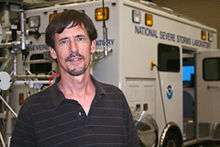Erik N. Rasmussen
| Erik Rasmussen | |
|---|---|
 |
|
| Born | January 27, 1957 |
| Fields | Meteorology |
| Institutions | NSSL, CIMMS, Rasmussen Systems |
| Alma mater |
University of Oklahoma (B.S., 1980) Texas Tech University (M.S., 1982) Colorado State University (Ph.D., 1992) |
| Thesis | Observational and Theoretical Study of Squall Line Evolution (1992) |
| Doctoral advisor | Steve Rutledge |
| Known for | Supercell and tornadogenesis research, field project leadership |
| Notable awards | Presidential Early Career Award for Scientists and Engineers |
|
Website www |
|
Erik Nels Rasmussen (b. January 27, 1957) is an American meteorologist and leading expert on mesoscale meteorology, severe convective storms, forecasting of storms, and tornadogenesis. He was the field coordinator of the first of the VORTEX projects in 1994-1995 and a lead principal investigator for VORTEX2 from 2009-2010 and VORTEX-SE from 2016-2017, as well as involved in other smaller VORTEX offshoots and many field projects.
Rasmussen was born in Hutchinson, Kansas to James and Ilse Rasmussen in 1957. His younger brother Neal, a software engineer, is also a storm chaser and is an accomplished videographer and photographer. Erik married Lisa Walters, an atmospheric scientist and oceanographer before embarking on a career as a pharmacist, and a storm chaser, in 1984.
Rasmussen's undergraduate meteorology study was at the University of Oklahoma (OU) in Norman where he received a B.Sc. in 1980. Here he was introduced to field research under Howard Bluestein, chasing supercells and tornadoes, and learning about thunderstorm structure and processes. He went on to graduate school at Texas Tech University (TTU) in Lubbock where he earned a M.Sc. in atmospheric sciences in 1982. In grad school he developed a reputation as a particularly adept forecaster and interceptor of severe storms and tornadoes and was nicknamed "The Dryline Kid" in reference to the dry line which initiates isolated storms and attendant tornadoes. His thesis was The Tulia Outbreak Storm: Mesoscale Evolution and Photogrammetric Analysis.
From 1982-1984, Rasmussen pursued further postgraduate work at the University of Illinois at Urbana-Champaign (UIUC). He worked at W.A.R.N. Inc., Now Weather Inc., WeatherData Inc., and PROFS (which became the Forecast Systems Laboratory or FSL before that unit was merged into the Earth System Research Laboratory or ESRL). He finished his Ph.D. at Colorado State University (CSU) in Ft. Collins in 1992. At CSU he participated in more field work, including researching squall lines in Australia and his dissertation was titled Observational and Theoretical Study of Squall Line Evolution.
...
Wikipedia
